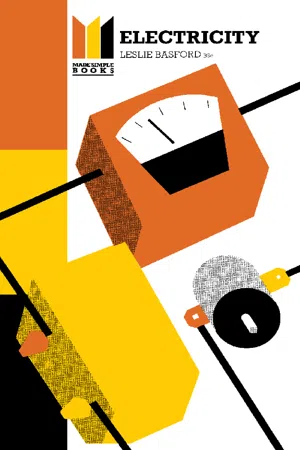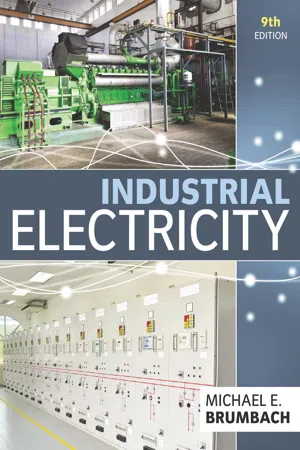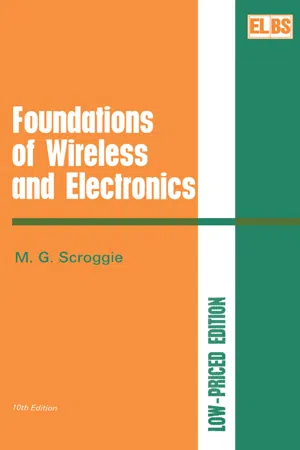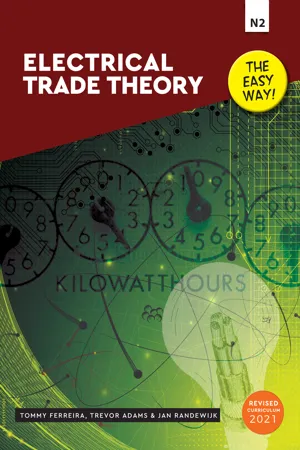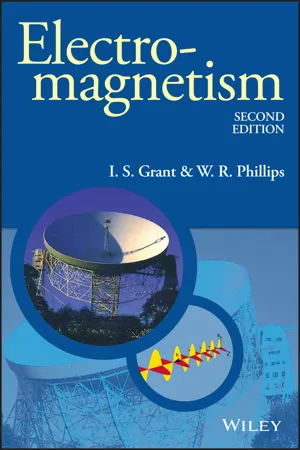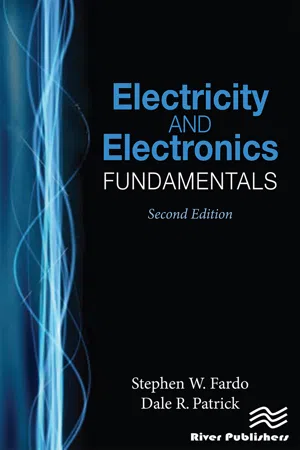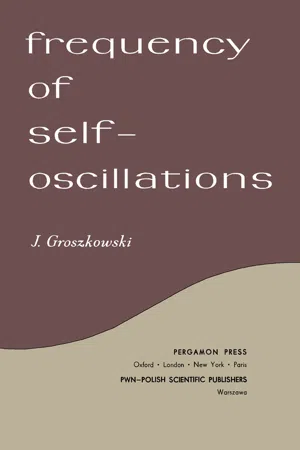Physics
Alternating Currents
Alternating currents (AC) are electrical currents that periodically change direction, oscillating back and forth. Unlike direct currents (DC), which flow in one direction, AC reverses direction at regular intervals. This type of current is commonly used in homes and businesses to power electrical devices and is the standard form of electricity delivered to households.
Written by Perlego with AI-assistance
Related key terms
1 of 5
11 Key excerpts on "Alternating Currents"
- eBook - PDF
Electrical Installations Technology
The Commonwealth and International Library: Electrical Engineering Division
- J. F. Whitfield, N. Hiller(Authors)
- 2013(Publication Date)
- Pergamon(Publisher)
C H A P T E R 1 0 Basic Alternating-current Theory 10.1. What is Alternating Current? Although direct-current systems and calculations are still indispensable to the electrical engineer, most public supplies are now alternating-current mains. The reasons for the changeover from d.c. to a.c. supplies will be considered in the next section, our puφose here being to indicate how the two systems differ. The easiest method of portraying an alternating quantity is to draw a graph showing how it varies with time, as in Fig. 10.1. Any part of the graph which lies above the horizontal (or zero) axis represents current or voltage in one direction, whilst values below it represent current or voltage in the other direction. The pattern given by the graph is known as the wave-form of the a,c. system, and this usually repeats itself. There is no need for the wave-form above the zero axis to have the same shape as that below it, although in -nost a.c. systems derived from mains supplies, this is the case. An alternating current is thus one which rises in one direc-tion to a maximum value, before falling to zero and repeating in the opposite direction. Instead of drifting steadily in one direction, the electrons forming the current move backwards and forwards in the conductor. The time taken for an alternating quantity to complete its pattern (to flow in both directions and then to return to zero) is called the periodic time (symbol T) for the system, which is said to complete one cycle in this time. The complete cycle is split into the '^positive half-cycle above the axis, and the ^'negative half-cycle below it. 196 B A S I C A L T E R N A T I N G -C U R R E N T T H E O R Y 197 FIG. 10. L Graph of an alternating current. The number of complete cycles traced out in a given time is called the frequency (symbol / ) usually expressed in cycles per second (c/s). - eBook - PDF
- Leslie Basford(Author)
- 2013(Publication Date)
- Made Simple(Publisher)
CHAPTER EIGHT ALTERNATING CURRENT An alternating current is one in which the electron flow changes direction periodically. So far we have dealt only with direct-current (d.c.) circuits where the electrons flow steadily in the same direction all the time. Because of their tremendous technical importance, we must now turn our attention to alternating-current (a.c.) circuits, in which the electrons oscillate backwards and forwards. We have already met (p. I l l ) the concept of an alternating e.m.f. developed when a coil of wire is rotated in a magnetic field. This e.m.f. rises from zero to a maximum value 2s m ax, then falls to zero again before increasing to a maximum with reversed polarity. The magnitude of the rising, falling, and reversing e.m.f. varies with the position of the coil according to the equation E = E m&x sin 6 The voltage of the a.c. mains supply varies in precisely the same way. In Great Britain and most of Europe the frequency of the a.c. mains is 50 Hz (cycles per second)*, and the mains voltage goes through a complete cycle (0, ismax 0, — ismax 0) 50 times every second. The current which this alternating voltage drives through a circuit connected to the mains varies at the same rate of 50 complete cycles (0, /max 0, —/max 0) every second. The magnitude of this alternating current at any instant is given by / = /max sin 8 It might be asked why alternating current is almost universally used in preference to direct current for the mains supply. The answer is very largely concerned with the ease with which the voltage of an alternating supply can be changed. This, as we shall see, is of prime importance in transmitting power efficiently from the generating station to the con-sumer. There are also practical difficulties associated with generating very large quantities of d.c. - eBook - PDF
- Michael Brumbach(Author)
- 2016(Publication Date)
- Cengage Learning EMEA(Publisher)
100 C H A P T E R 7 Alternating Current O B J E C T I V E S After studying this chapter, the student will be able to: ■ Explain the difference between alternating current and direct current. ■ Describe the basic principles of alternating current. ■ List the advantages and disadvantages of alternating current. ■ Describe the characteristics of alternating current with regard to resistance, inductance, and capacitance. ■ Define power in AC circuits and power factor. Copyright 2017 Cengage Learning. All Rights Reserved. May not be copied, scanned, or duplicated, in whole or in part. Due to electronic rights, some third party content may be suppressed from the eBook and/or eChapter(s). Editorial review has deemed that any suppressed content does not materially affect the overall learning experience. Cengage Learning reserves the right to remove additional content at any time if subsequent rights restrictions require it. ALTERNATING CURRENT 101 BASIC AC THEORY Alternating current is the primary source of electri-cal energy today. It is less expensive to generate and transmit than direct current. AC equipment is gen-erally more economical to maintain and requires less space per unit of power than DC equipment. While direct current is unidirectional and of a con-stant value, alternating current not only reverses di-rection periodically but also varies in strength. The standard AC generator (alternator) produces a voltage that, if plotted on a graph, forms a curve similar to that in Figure 7–1. This curve, called a sine wave, shows that the voltage increases from zero to a maximum value in one direction, drops to zero, increases to a maximum value in the opposite direc-tion, and drops to zero again. When such a change in values has taken place, a cycle has been completed. From then on, the cycle is merely repeated. The number of cycles completed in 1 second is called the frequency . The unit of measurement of frequency is hertz (Hz). “Hertz” refers to cycles per second. - Available until 8 Feb |Learn more
- T Ferreira(Author)
- 2013(Publication Date)
- Future Managers(Publisher)
ELECTROTECHNOLOGY 6.1 Direct current When a current flows in one direction only, it is known as direct current (dc). This occurs when the polarity of the power supply terminals remain the same. Primary and secondary cells and batteries as well as dc generators are common power sources for direct current. It is also common practice to convert alternating current to direct current by means of various rectifier units. A battery charger is a good example. 6.2 Alternating current In the case of alternating current, as the name implies, the current reverses its direction at a constant rate. This occurs as a result of the constant reversal of polarity at the output terminals of the power supply. The pd and therefore the current through the circuit, builds up gradually from zero to a maximum value in one direction (which could be taken as the positive direction) and then decreases again to zero. At this point in time, the pd reverses its polarity and gradually builds up to its maximum again before decreasing to zero. This is known as one complete cycle. The rate at which these cycles recur per second is known as the frequency of the supply and is measured in hertz. In the RSA the frequency is standard at 50 hertz (50 hz). Extensive use is made of alternating current for power generation and distribution. The majority of electrical machines and appliances operate from an alternating current supply. Ac voltages are quite easily stepped up or down by making use of transformers. 6.3 Generation of a single-phase alternating EMF In order to gain better insight into alternating current, the operation of a simple single- phase generator is explained overleaf. 6 CHAPTER Alternating current theory Chapter 6 • Alternating current theory 60 This emf can be represented by a sine wave as shown in fig. 6.1 (a), which represents a two-pole generator with the armature rotating in an anticlockwise direction through a uniform magnetic field. - eBook - PDF
- M. G. Scroggie, S. W. Amos(Authors)
- 2013(Publication Date)
- Newnes(Publisher)
CHAPTER 5 Alternating Currents 5.1 Frequencies of Alternating Current In our first chapter we saw that speaking and music are conveyed from one person to another by sound waves, which consist of rapid vibrations or alternations of air pressure. And that to transmit them over longer distances by telephone it is necessary for electric currents to copy these alternations. And further, that for transmitting them across space, by radio, it is necessary to use electric currents alternating still more rapidly. Of course we must never forget that sound waves and radio waves are quite different in nature, sound waves being mechanical vibrations of material substances (solid, liquid or gas) whereas radio waves are oscillations of electric and magnetic fields which can cross interstellar space. We have now just noted the fact that the great advantage of being able to step voltages up and down as required is obtainable only when the electricity supply is continually varying, which is most conveniently done by arranging for it to be alternating. Public electricity supplies which light and heat our houses and provide the power that works our television receivers and many other facilities are therefore mostly of the alternating-current kind. The only essential difference between all these Alternating Currents is the number of double-reversals they make per second; in a word, the frequency. We have already gone fairly fully into the matter of frequency (Sec. 1.4), so there is no need to repeat it; but it may be worth recalling the main divisions of frequency. There is no hard-and-fast dividing line between one lot of frequencies and another; but those below 100 Hz are used for power (the standard in Britain is 50 Hz); those between about 20 and 20 000 Hz are audible, and therefore are classed as audio frequencies (a.f.); while those above about 15 000 are more or less suitable for carrying signals across space, and are known as radio frequencies (r.f.). - eBook - PDF
- Paul Rosenberg, Robert Gordon Middleton(Authors)
- 2004(Publication Date)
- Audel(Publisher)
Chapter 6 Principles of Alternating Currents An alternating voltage or current is usually defined as a voltage or current that changes in strength according to a sine curve. An al-ternating voltage reverses its polarity on each alternation, and an alternating current reverses its direction of flow on each alterna-tion. Electricians usually speak of AC voltage and AC current. An AC generator is commonly called an alternator. Automotive electri-cians are concerned with the repair and maintenance of alternators. Figure 6-1 shows the development of an AC voltage. The point of maximum voltage occurs at 90 ◦ and is also called the crest voltage or peak voltage of the sine curve. Frequency The frequency of an AC voltage of current is its number of cycles per second. For example, electricity supplied by public utility com-panies in the United States has a frequency of 60 cycles per second (60 cps). Electricians sometimes call cycles per second by the newer name, hertz. Thus, 60 cycles per second is the same as 60 hertz (60 Hz). Figure 6-2 shows the relation between time and voltage at a frequency of 1 cps. Each alternation is completed in 1 / 2 second. In this example, the time for one complete cycle, called the period of the AC voltage, is 1 second. If an AC voltage has a frequency of 60 cps, its period is 1 / 60 second. Instantaneous and Effective Voltages An instantaneous voltage is the value of an AC voltage at a particu-lar instant. For example, the maximum voltage shown in Figure 6-1 is an instantaneous voltage; the positive maximum voltage occurs at 90 ◦ , and the negative maximum voltage occurs at 270 ◦ . Electri-cians generally consider that the most important instantaneous AC voltages are the maximum (crest or peak) voltage and the effective voltage. We will first explain what is meant by the effective volt-age and then observe why it is so important. The effective voltage is 70.7 percent of the peak voltage and occurs at 45 ◦ , as shown in Figure 6-3. - eBook - PDF
- Mike Tooley, Lloyd Dingle(Authors)
- 2010(Publication Date)
- Routledge(Publisher)
KEY POINT Alternating Currents are currents that continuously change their direction of flow. Direct current, by comparison, only flow in one direction Electrical and Electronic Principles 524 UNIT 6 A S N B A S B B S A N N A S N B B S N A Generated voltage 0 Angle, u 0° 90° 180° 270° 360° Figure 6.100 e.m.f. generated at various angles 720° 630° 540° 450° 360° 270° 180° One revolution Voltage, V V max V max 90° 0° 0 Angle, u Figure 6.101 Sinusoidal voltage produced by the rotating loop Voltage 0 0 Time Period, t t 4 Frequency, f 1 t t 2 3t 4 t Figure 6.102 One cycle of a sine wave voltage Electrical and Electronic Principles 525 UNIT 6 The relationship between periodic time and frequency is thus: t f f t 1 1 or where t is the periodic time (in s) and f is the frequency (in Hz). Example 6.53 A waveform has a frequency of 400 Hz. What is the periodic time of the waveform? t f 1 1 400 0 0025 2 5 . . s (or ms) Example 6.54 A waveform has a periodic time of 40 ms. What is its frequency? f t 1 1 40 10 25 3 Hz TYK 6.36 (a) An AC generator produces a supply voltage with a period of 22 ms. What is the frequency of the supply? (b) A radio signal has a frequency of 200 kHz. What is the periodic time of the signal? Equation for a sinusoidal voltage The equation for the voltage shown in Figure 6.101 at an angle, θ, time, t, is: v V max sin θ where v is the instantaneous voltage, V max is the maximum (or peak) voltage of the sine wave and θ is the angle at which the voltage is measured. It is often more convenient to express a sinusoidal voltage in terms of time rather than angle. Since we know that one cycle of the wave corresponds to an angle of 360° (or 2 π radians) we can replace θ in the foregoing formula with: θ ω t where ω is the angular velocity (i.e. the rate at which the coil is turning expressed in degrees per second). T e s t y o u r k n o w l e d g e TYK - Available until 8 Feb |Learn more
- Tommy Ferreira, Trevor Adams, Jan Randewijk, Tommy Ferreira, Trevor Adams, Jan Randewijk(Authors)
- 2021(Publication Date)
- Future Managers(Publisher)
In electrical technology we also refer to single-phase systems and three-phase systems with regard to electricity generation, each one with its own advantages and disadvantages. 1 MODULE Alternating current circuit theory ELECTRICAL TRADE THEORY 2 Module 1 • Alternating current circuit theory Definitions Alternating current (AC) – an electric current that reverses its direction many times a second at regular intervals Conductor – a substance or material that can freely conduct the flow of charge carriers in the form of electrons from one atom to another in a specific material Delta connection – when three coils are connected in series to form a closed loop Power factor – the ratio of true power to apparent power Star connection – the three common ends of the coils are connected to form a terminal called the neutral (N) Transformer – device used to step a voltage up or down with a corresponding decrease or increase in current 1.1 Dynamically induced emf 1.1.1 The magnitude of an emf induced in a rotating conductor The induction of an emf in any conductor is based on the principle of electromagnetic induction. Whenever we speak about electromagnetic induction, the name of Faraday always comes up. He discovered that an electric current produces a magnetic field and conversely, that a changing magnetic field generates an electric current in a conductor. Faraday’s two laws of electromagnetic induction are as follows: • An emf can be induced in a conductor whenever there is a change in the magnetic flux linking with the conductor. • The magnitude of the induced emf is directly proportional to the rate of change of the magnetic flux linking with the conductor. Put simpler, when there is relative movement between a conductor and a magnetic field, an emf is induced in the conductor. The word ‘relative’ means either the conductor or the magnets may be moved to produce this emf. This type of induced emf is also called dynamically induced emf. - eBook - ePub
- I. S. Grant, W. R. Phillips(Authors)
- 2013(Publication Date)
- Wiley(Publisher)
CHAPTER 7
Alternating Currents and transients
In the last chapter it was shown how an induced e.m.f. occurs whenever the magnetic flux through a circuit is changing. By introducing the concept of inductance, we were able to use Faraday’s law to express induced e.m.f.s in terms of the rate of change of currents. We must now look at the opposite problem, and investigate the response of the currents in a circuit to known changes in the e.m.f.s driving them. This chapter is principally concerned with circuits in which both the currents and the e.m.f.s are varying sinusoidally with time. Such circuits are referred to as alternating current circuits, or A.C. circuits for short. There are good reasons for concentrating on the sinusoidal form of time variation. In the first place, many commonly occurring sources of e.m.f. do in fact vary sinusoidally. More importantly, in a circuit containing inductors and capacitors, sinusoidally varying e.m.f.s lead to sinusoidally varying currents, although as we shall see, the e.m.f.s and currents may not be in step with one another. The useful property of having the same functional form for e.m.f.s and current is not shared by any other type of time variation. Finally, according to Fourier’s theorem, all functions may be expressed as a superposition of sine functions. It follows that we can predict the response of a circuit to any time variation of e.m.f. once we know its behaviour for Alternating Currents of all frequencies.7.1 ALTERNATING CURRENT GENERATORS
Energy is dissipated when an electric current flows through a material with non-zero resistivity, and a continuous source of power is therefore needed to maintain a current in a circuit, except in the special case of superconductors. Consider the energy dissipated when a source of e.m.f. V drives a current I through a resistor. An amount of work V dq is required to move a charge dq through the potential difference V - Dale R. Patrick, Stephen W. Fardo(Authors)
- 2020(Publication Date)
- River Publishers(Publisher)
Chapter 2 Alternating Current (ac) Electronics INTRODUCTION Alternating current (ac) electronics is some- what more complex than direct current (dc) electronics. Alternating current circuits, like dc circuits, have a source of energy and load in which power conversion takes place. Most of the electrical energy produced in our country is alternating current; therefore, ac systems are used for many applications. In terms of electronic circuits, there are three important characteristics present in ac circuits. These characteristics are resistance, inductance, and ca- pacitance. Also, there are two types of ac voltage—single- phase and three-phase. OBJECTIVES 1. Explain the difference between ac and dc. 2. Define the process of electromagnetic induction. 3. Describe factors affecting induced voltage. 4. Draw a simple ac generator and explain ac voltage generation. 5. Convert peak, peak-peak, average, and RMS/ef- fective values from one to the other. 6. Explain the relationship between period and fre- quency of an ac waveform. 7. Recognize the different types of ac waveforms. 8. Measure alternating current with an ac ammeter. 9. Use a multi-meter to measure ac voltage. 10. Explain the basic operation of an oscilloscope. 11. Explain how an oscilloscope can be used to mea- sure the amplitude, period, frequency, and phase relationships of ac waveforms. 12. Explain how an ac voltmeter is used to measure ac voltages. 13. Perform basic ac circuit calculations. 14. Define and calculate impedance. 15. Draw diagrams illustrating the phase relationship between current and voltage in a capacitive circuit. 16. Define capacitive reactance. 17. Solve problems using the capacitive reactance for- mula. 18. Define impedance. 19. Calculate impedance of series and parallel resis- tive/capacitive circuits. 20. Determine current in RC circuits. 21. Explain the relationship between ac voltages and current in a series resistive circuit.- eBook - PDF
- Janusz Groszkowski(Author)
- 2013(Publication Date)
- Pergamon(Publisher)
1 1.1. Alternating Currents and Oscillations Alternating Currents find universal application in the manifold fields of modern life, the ranges of their frequencies and power-outputs being more and more ex-tended. The currents of frequencies known as industrial (ranging from several cycles per second up to several tens of cycles per second) are obtained by electromotive forces induced in alternators in which the direct conversion of mechanical to elec-trical energy occurs; the frequency of the electromotive force is determined by the external parameter of the alternator, viz. by its rotor angular velocity, at which mechanical energy is supplied. The currents of frequencies lower or higher than industrial are produced mostly as electric oscillations (or more precisely—as self-oscillations) in oscillators in which electric energy, usually as d.c, is converted in electric oscillations of desired frequency. The oscillations are excited and maintained automatically; their frequency is almost independent of external factors, being determined mainly by the intrinsic parameters of the oscillatory system. For more than a hundred years the problem of electric oscillations has given rise to a deep interest from the theoretical as well as from the practical point of view. The technique of generating electric oscillations has faced newer and newer requirements with respect to the larger frequency ranges of oscilla-tions, various forms, improved frequency-stability, larger power-output and I N T R o D u c T I o N 2 1. INTRODUCTION higher efficiency. In consequence, a large and special field of theory and practice devoted to problems of generation of electric oscillations and of frequency stabilization has been created and developed. Progress in the production of electric oscillations is closely connected with the history of radio communication. It lies in the period of time which preceded the achievements of A.S. POPOV and the invention of G. MARCONI. It is a notable fact that W.
Index pages curate the most relevant extracts from our library of academic textbooks. They’ve been created using an in-house natural language model (NLM), each adding context and meaning to key research topics.

